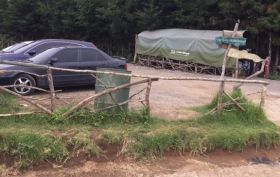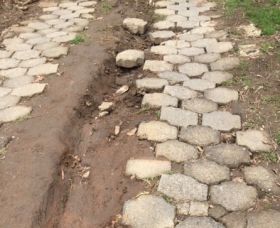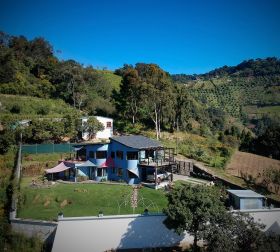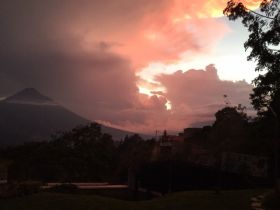The Road to “Hobbitenango” - Part 4
"What is Hobbitenango?"
Many of my stories involve a place up the hill near us called Hobbitenango, and before I write about building my house here, I must explain what Hobbitenango is. “Tenango” is a Mayan suffix to many of the names of towns in Guatemala, meaning “the place of.” Jocotenango is the place of the Jocos, Alotenango is the place of the Alos, Chimaltenango the place of the Chimals, etc. So this place near us is the place of …. you guessed, the Hobbits, and its theme is based on the stories of Tolkien's Lord of the Rings.
In the beginning weeks of our construction, the locals were telling us that somebody was building a FIVE STAR HOTEL up the hill above us. Our house is on a steep slope and beside a very steep, one lane road that changes from two paths of stones for tires in front of our house to two dirt ruts as it continues up the hill. That eventually changed a bit in the future, but it’s part of the story to come.
.jpg)
You can see how steep it looks. When you get to the top of the hill and the steepest part, it turns to the right and levels out along the ridge line of the hill. Bonnie and I hiked up there one day to see this hotel construction, finding it dubious that any such 5 star quality business would place itself up a single lane dirt rutted road. We followed the ridge several hundred meters, about 10 or 15 minutes, and enjoyed the wonderful spacious views all along the way. The altitude is around 7500 feet, so it’s a hike. On either side of the level road, or two footpaths really, were fields being farmed mostly with flowers and corn. Most of the trees had been cut down to make these fields, and almost none of the farmers even own vehicles to get up there to work. They walk. When we got to the end of the road there were sure enough a couple of buildings, but they were definitely not going to be anything warranting five stars.
.jpg) Farmers blocking access along the road.
Farmers blocking access along the road.
The buildings were made of mud-earth, tree trunks and branches, plastic bottles filled to make them like bricks embedded in the mud, as well as some glass bottles. There was a rustic bunk house with a communal bathroom behind it in one structure, and the other was the beginning of a bar and restaurant.
The guardian there in charge of the place is named Armando. He wore a huge sombrero, typically Mexican and NOT Guatemalteco, and was very friendly. He offered to show us around and tell us the plans for the future. He said nothing about Hobbits or Five Stars and didn’t seem to know what that meant. He showed us the vegetable garden, plans for taking water off the roofs, how the place would have a roof tucked into the hillside with grass growing on it. He had a few goats with him that were happily eating grass on the slopes, each one tied separately from the others so they’d graze where he wanted them to and keep the grass short. Even though he didn’t know about Hobbits, this was the place that was to become a major destination for Guatemaltecos from Guatemala City, made famous by going viral on Facebook. It won’t make five stars, but it has become amazingly popular, eventually drawing as many as 200 to 300 people a day on weekends, and during holidays as many as 1,000, making it impossible for them to give good service. The growth in the last few years has resulted in it being like a movie set for filming Lord of the Rings.
.jpg)
The Hobbitshire as it looks now.
Now imagine this: there is a one-lane dirt road going up a very steep incline to get to this restaurant, with a ninety-degree turn at the crest where you cannot see a vehicle coming along the ridge. They have little parking space up there even if vehicles could make it up the hill, which many cannot. In an area below our house they leased a small piece of land to make a parking lot and hired a man with a truck to carry the guests up the hill in the back of his pickup. (the word for pickup truck here is “peekoop.”)
The driver’s name is Bernabay. It’s not very comfortable to sit in back of a pickup truck when you are bouncing around and have nothing to hold on to, so Bernabay soon had his truck modified with wooden benches. Later he added bars, like a cage, so people can also stand up and hold onto the bars. He can put a tarp over the bars for when it is raining. This is Burnaby's personal truck and he was collecting money from the guests directly. Hobbitenango said he had to share the money with them, half and half. Then it wasn’t enough for one truck, so more vehicles and drivers were added to take people up the hill, and two more parking lots were opened below. People were coming in their own cars from Guatemala City so fast they couldn’t keep up with it all. More cars, more cars, and no place to put them. And drivers of the vehicles were soon cheating Hobbitenango by taking most of the money they collected. A lot of headaches for the owners of the restaurant.
Cars were lined up on the public highway on weekends as well. Hobbitenango hired a man to go on the highway and collect parking fees, but this is against the law because it is a public road. We found out that they made a deal with the mayor of the next town, Vuelta Grande, that if they promised not to tell anybody, they would collect parking fees and split it, half to the business and half to the town. Or maybe that half went right into the pocket of the mayor. Who knows?

Parqueo de Hobbitenango.
That didn’t last very long. The two new parking lots helped a lot. They are owned by farmers who figured out it is easier to have a parking lot than to keep planting crops over and over, harvest and sell them, than just to make spaces to put cars, have one employee collecting the money … piece of cake. Eventually even three parking lots weren't enough, and more villagers started to realize they could make money, too, turning their land into parking lots instead of growing things.
At first Hobbitenango was telling them they had to give half the parking fees to them because they were bringing the customers. Luckily the villagers knew that wasn’t right and disagreed. Three years later we now have nine parking lots around here; just dirt fields, some with white powder markings to show spaces for vehicles. And we have now four restaurants, including Hobbitenango because there are so many people going up there they cannot feed everybody.
Then the villagers figured out that they can sell food, too. They put up some small tables on the public highway across the road from the parking lot and started selling plants, vegetables, flowers, and tortillas. We heard a rumor that Hobbitenango tried to tell them as well that they had to pay a commission for bringing the customers, but they too fought back. Now many people are making money around here and the area is growing in popularity. The indigenous people of Guatemala are very resourceful and clever. And we are amazed that our plan to live in a quiet country setting is bollixed by the place called Hobbitenango. For us there is a huge traffic and congestion problem.
.jpg)
The Steepest Part at the blind curve.
Sometimes people try to drive their own vehicle up the hill to Hobbitenango. Imagine what happens at the corner where they can’t see who is coming from the level ridge to go DOWN the hill when they are trying to go UP. There is no place to pass each other. By now there were at least three shuttles, sometimes four going up and down to two restaurants up there, not just Hobbitenango.
The drivers and land owners on top of the hill all carry short wave radios so they can talk to each other and coordinate how they are going to manage the traffic flow. Between the parking lots and Hobbitenango there are only about 3 or 4 places where two can pass each other.
When someone in their own vehicle tries to drive up the hill, they don’t know who is coming down and they get stuck, requiring them to back down and keep their tires on the narrow channels of stones. There have been accidents, damages to vehicles, motorcycles and to humans as well.

Stones come loose in the rains; can tumble downhill.
The other land owners up there who use vehicles to get to their property eventually joined with Hobbitenango owners to improve the road. They put some stones along the two channels leading up there. These are interlocking cement stones used commonly in Guatemala to build roads and streets. The interlocking feature is normally quite successful, but when you put only a few together without crossing the whole road surface, on a slope, there is no security for these stones to remain interlocked.
Trucks, motorcycles, cars were all trying to get up the hill, and the stones didn’t stay in place. They are BIG cement pieces, weighing about 6 pounds each. When the rainy season came, some stones came loose and came tumbling down the hill past our house. Motorcyclists go up this steep hill and some can’t make it, slow down, and they fall over. I have treated a half dozen people with first aid who got injured. We took one guy to the hospital with a broken arm and his buddy had to come back later for his cycle.
On another day a motorcyclist fell off his cycle on the steepest part above us and broke his leg. His friends called an ambulance. Ambulances here are mostly like vans used for tours that carry 12 or so people. The ambulance that day could not make it past our house and kept trying, burning the tire rubber onto the stones for so long that it overheated the engine and shut down completely. They called a second ambulance and the medics had to carry the patient down the hill on a stretcher to it. The first ambulance was by now blocking the one land road so nobody could pass up or down. Soon one of Hobbitenango’s shuttle trucks came from above with a rope, tied it to the ambulance and lowered it down to the bottom where the parking lots are.
.jpg)
"Improvements" by Hobbitenango.
My worries about the dangers are always there, mostly because these shuttle trucks go up and down all day, over and over, using their brakes all day long, tires wearing out. One of the drivers, a friend of Zaqueo, told us that Hobbitenango does not do checks of brakes and service often enough.
The greatest way to get to know a whole neighborhood might be to have community meetings where everyone has something to say about the new restaurant/hotel up on the hill. We had several of such meetings, but I can’t say it was a friendly way to meet neighbors. Some people were happy to have the Hobbits here because there were jobs for locals: masons, construction workers, waiters, people to clean rooms, and the parking lots eventually proved to be the biggest money-makers. The meetings were run by the current mayor of the town of Vuelta Grande, and he was accompanied by a secretary to write notes and a few others whose job was unclear. The mayor would call on people to let them air their complaints, then follow that by at least five minutes of his own opinion and so-called summary of what was said, while the scribe took down notes in long-hand in a big notebook.
As people griped, some of their voices would get loud and their faces get red, until the mayor had to interrupt and try to get order back. I didn’t understand most of it because their accent is affected by them having little education and local dialect. Their Spanish is nothing like what I learned in classes in Antigua where they speak slowly, perfect grammar, and very little accent at all. When I asked Zaqueo what I missed, he often said they were arguing with each other about old personal wounds they have carried for years, having nothing to do with Hobbitenango’s presence. What did come out was a lot of unhappiness about the traffic going up and down the hill and damage to the road. Hobbitenango was wearing it down and beating it up far more than any others who have land up the hill, so they felt Hobbitenango should fix the road.
Farmers with crops along the road complained that their plants have so much dust on them from the traffic that the growth has been stunted. Flowers to go to market are covered with dust that has to be shaken off. Women in the area complained that their laundry hung out on lines is getting dirty all over again from the dust. Dust was being kicked up not only on the road, but from all the parking lots as well.

Ojo de la Mariposa is us. Blue house. Hobbitenango is at top on ridge, right of center.
When it was my turn to speak as a homeowner, I said my biggest worries were the dangers associated with the traffic. We saw many vehicles having to come down unsafely, trying to stay on the stones, getting stuck, and having to be pulled out. We saw the big stones go rolling past our house a few times, and I worried about safety of pedestrians on the hill. When the rains come, the stones get loose and vehicles get stuck or slide off the stones into a ditch. I felt Hobbitenango should maintain the road because they have a business that brings in income, while the rest of us live along it without revenue from it.
There are no options anyone can think of for making a bigger, safer road. The farmers do not want to give up right of way to make two lanes. In fact, in the beginning the shuttle trucks were passing onto their farm land to pass each other, so farmers put barbed wire fences up to keep them off their fields. They made them very close to the lane, even causing some wider vehicles to get scratched when they pass the fences. This also caused a problem for pedestrians, both locals and guests of Hobbitenango who walk up the hill, to have to squeeze up against the barbed wire to let vehicles pass. For a long time the road along the ridge was just two dirt ruts, so in rainy season they were mud, slippery and dangerous for pedestrians, and places to get stuck for vehicles.
Over time, some of the problems have simmered down, the rest have just been accepted as without solutions. All of it has caused division in the community, leaving some content because they make money and some just irritated and choosing sides. Like a lot of places in the world, right?

But how can we complain when we have daily views like this?
Come back later for more stories about building our house.


